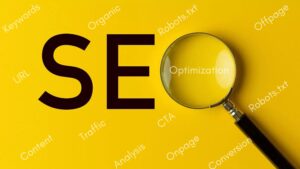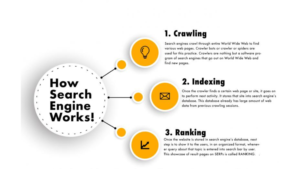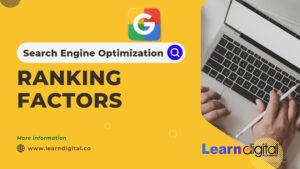
SEO website ranking in Google is the process of creating organic traffic. It is about the content and the relevancy of a given keyword. SEO is the process of quality & quantity traffic from free also known as organic, editorial, or natural search results in search engines. The aim is to improve your website’s position on search engine results pages. So, the higher the website is listed on sites, the more people will see it.
Are you just getting started with SEO? Maybe you’ve heard that SEO can help your website receive more traffic and higher ranks, but you’re not sure how it works or where to start? You’ve arrived at the correct location. Continue reading to learn what every digital marketer needs to know about SEO.
Defining Search Engine Optimization (SEO)
Let’s begin with a simple question about SEO website ranking:
Firstly, what precisely is SEO? SEO stands for ‘Search Engine Optimization,’ and it is the practice of obtaining traffic from search engines’ free, organic, editorial, or natural search results. Its goal is to boost your website’s ranking on search engine results pages. Remember that the higher up on the list your website is, the more people will see it.
- Identifying relevant keywords with high search traffic potential is only one example of what successful SEO entails.
- Creating and optimising high-quality, valuable content for search engines and users
- Relevant links from high-quality websites are included.
- Taking measurements of the outcomes
Nowadays, SEO is seen as a necessary marketing activity.
SEO website ranking – Differences between paid and organic search
It’s critical to understand the differences between organic, natural search (also known as SEO) and paid search right away. There are five major distinctions:
Position
The first distinction is that paid search results display above organic results on search engine results pages, whereas organic results appear below them.
Time
Another significant distinction between sponsored and organic search is the amount of time spent on each. Paid search results are almost instantaneous, often even in minutes, whereas organic search results take weeks, months, or even years to appear. As a result, the organic search must be approached in a medium- to long-term manner.
Payment
When it comes to payment, paid search traffic is paid, as the name implies. On a cost-per-click (CPC) basis, you pay per click (PPC). That is, you are charged a price each time a user clicks on your ad. So, rather than depending on organic traffic to your website, you buy it by paying Google to show your ad when a visitor searches for your keyword. Organic search traffic is free, but it does necessitate a financial and time investment.
ROI
Paid search is actually easier to assess in terms of return on investment, or ROI. This is partly due to the fact that Google provides additional keyword data for you to collect in Google Analytics. Paid search, on the other hand, can see its ROI stagnate or fall over time. Organic search ROI is a little more difficult to quantify, but it usually improves over time. Organic search can provide a very strong return on investment in the long run. SEO website ranking will help in getting you a good ROI when done in the right way in the long run.
Share of traffic
When it comes to traffic, about 20% to 30% of searchers click on paid results, while 70% to 80% of searchers click on SEO results. As a result, the organic results receive the lion’s share of clicks.
Paid and organic searches have certain similarities.
It’s not just about the contrasts; paid and organic search has certain parallels as well:
Keyword research: Both sponsored and organic search employ a search engine, and both require a user to enter a query. As a result, you must conduct keyword research for both organic and sponsored searches.
Landing pages: Both forms of searches necessitate the creation of landing pages. The landing page must be linked to your website for SEO purposes. It might be the same landing page you use for organic search, or it can be a whole distinct standalone page of your website for paid search.
Traffic: The purpose of both sponsored and organic search is to generate traffic. Most essential, user intent is present in both sponsored and organic search traffic. That is, when someone asks Google a question or searches for information, they are in an active mentality, and as a result, they are more likely to act on the information they receive.
The three pillars of SEO
Knowing how to get your brand, website, or company found by searchers is a core skill for a digital marketer, and understanding how SEO is changing will keep you on top of your game. While SEO changes in subtle ways on a regular basis, its core principles remain constant. We can divide SEO down into three main components or pillars that you should be aware of and use on a regular basis:
Technical optimization: Technical optimization is the process of completing tasks on your site that are not linked to content but are intended to increase SEO. It frequently occurs behind the scenes.
On-page optimization: On-Page Optimization is the process of ensuring that your site’s content is relevant and provides a positive user experience. It entails using a content management system to target the appropriate keywords inside your material. WordPress, Wix, Drupal, Joomla, Magento, Shopify, and Expression Engine are all examples of content management systems.
Off-page optimization: Off-Page Optimization is the process of improving your site’s search engine rankings through activities that take place outside of the site. Backlinks, which serve to create the site’s reputation, are a big part of it.
What are the inner workings of a search engine?
People use search engines when they have a question and want to find an answer on the internet. Search engine algorithms are computer programmes that search for hints in order to provide searchers with the exact results they need. Algorithms are used by search engines to identify websites and determine which ones to rank for a given keyword. Crawling, the discovery stage, indexing, the filing stage, and ranking, the retrieval stage, are the three stages of how search engines work.
Step 1: Crawling
Crawling is the first step. Web crawlers are sent out by search engines to find new pages and gather data about them. These web crawlers are also known as spiders’ or ‘robots.’ Their goal is to find new web pages and to examine the content of pages they’ve already visited to see whether it’s changed or updated.
Search engines crawl web pages by following previously found links. When a search engine scans your homepage, it will look for another link to follow and may follow the link to your new blog post if you have a blog post connected to your homepage.
Step 2: Indexing
Indexing is the next stage. When a search engine determines whether or not to use the content it has crawled, it is called indexing. A search engine will add a crawling web page to its index if it is judged worthy. This index is utilised in the final stage of ranking.
When a web page or piece of material is indexed, it is filed and saved in a database from which it can be retrieved at a later
time. The index contains the majority of web pages that have unique and valuable material. If a web page meets the following criteria, it may be excluded from the index:
- Its content is regarded as redundant.
- Its content is regarded as low-quality or spammy.
- It was impossible to crawl over it.
- Inbound links were missing from the page or domain.
Step 3: Ranking
The third and most critical phase, ranking, is the most important. After the crawling and indexing stages are completed, ranking can begin. Your site can be ranked once it has been crawled and indexed by a search engine.
Search engines utilise over 200 ranking signals to categorise and rank material, all of which fall under the three pillars of SEO: technical optimization, on-page optimization, and off-page optimization.
The following are some examples of SEO website ranking signals used by search engines.
Keyword presence in the title tag – Use the Synonyms in the title tags
The loading speed of webpage – Web page loading time – Whether the website is mobile-friendly and loads rapidly.
Website reputation – Websites are considered reliable for the topic being looked up.
SEO website ranking – Ordering and ranking results
Google Hummingbird is the company’s core search algorithm, and it determines how search engine results are ordered and ranked.
RankBrain is a machine-learning search engine sub-algorithm developed by Google:
- If RankBrain encounters a word or phrase it is unfamiliar with, it employs artificial intelligence to help it comprehend it by linking it to related search queries.
- It enables Google to comprehend these inquiries by transforming keywords into
well-known themes and concepts, allowing it to give better search engine results — even for unique queries.
- RankBrain promotes websites that deliver user pleasure and return the result that the user expects, rather than aiming to be the best keyword-optimised result.
Using RankBrain to its full potential
Optimizing your website for better user experience and happiness, as well as making the most of the RankBrain ranking factor, is a good SEO strategy for better SEO website ranking.
The three most effective ways to do this are:
- Prioritize Medium-tail keywords (key terms consisting of two to three words).
- Always optimize page names and descriptions for clicks so that your listing is more likely to be clicked when a user searches for your keyword. The click-through rate refers to the percentage of people who find you on Google and subsequently visit your website.
- Increase dwell time (the number of time users spend on a page) and decrease bounce rate by optimising content (the percentage of visitors who leave after only viewing one page).
Remember, Google’s top three ranking factors are:
- Links
- Content
- RankBrain
SEO website ranking – Identifying SEO goals
Setting SEO goals is an essential component of any SEO plan & SEO website ranking. Setting SEO goals – and aligning them with your entire business goals – is critical because:
- Inviting key stakeholders to join in.
- They assist you in developing your SEO strategy.
- Helps in making certain that meets objectives.
SEO website ranking – What should you measure?
SEO website ranking Setting objectives may appear to be a time-consuming chore, but assessing them can help you make long-term development with your SEO. So, what kinds of items should you keep track of?
Consider the following measurements:
- Keywords
- Traffic
- Market share
- Brand awareness
- Lead generation
- Reputation
- E-commerce
SEO website ranking – SEO objectives examples
Here are three examples of SEO objectives that you can use as a starting point for creating goals for your own company or website:
“Within nine months, move 50% of our top 20 keywords to the first page of Google.” This goal is all about keyword ranking.
“In the coming fiscal year, increase our SEO market share from 3% to 5%.” This goal focuses on increasing market share.
“Increase organic traffic by 20% year over year in the third quarter and 25% in the fourth quarter.” The goal of this goal is to increase organic website traffic.
SEO website ranking – Setting goals for various sorts of businesses
Depending on whether your company is transactional or informational, your goals will be different.
If you run a transactional firm with an e-commerce component, you’ll want to focus your goals on tracking sales and lead conversions. If you’re running a non-eCommerce commercial site, though, you should concentrate on lead creation.
Similarly, If you run an informative business, you’re more likely to set goals centred on brand awareness or website traffic. Finally, keep in mind that SEO is never complete, even if you have fully implemented your SEO strategy. When it comes to SEO, you may need to switch strategies in the middle of the game, play a long game, and wait for the final outcomes. However, with a good SEO foundation in place – and a little patience – the benefits of your SEO strategy should become obvious, resulting in a better client experience and more conversions for your company.
SEO website ranking – Conclusion:
Learn Digital Academy is a one-stop-shop specializing in providing top-notch marketing certification courses and Digital marketing training in Bangalore to marketers across the globe. The institute has set up a platform that facilitates the dissemination of knowledge related to digital media marketing, with an eye on infusing some innovative thinking in their business strategies. It offers training for various industry programs that covers aspects like SEO, SMM, PPC, Content Writing, and Video Marketing.
Follow us on Facebook, Instagram, Linkedin, Twitter, Quora, Pinterest, and Youtube.






